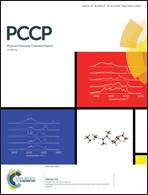Dissociation channels, collisional energy transfer, and multichannel coupling effects in the thermal decomposition of CH3F†
Abstract
The thermal unimolecular decomposition of CH3F has been studied with the aim of elucidating the multichannel character of the reaction. Experimentally, the temporal profiles of HF were recorded following the decomposition of CH3F in a shock tube. The profiles indicated that the yield of HF is close to unity at a pressure of ∼100 kPa (Ar bath) over the studied temperature range 1888–2279 K. The reaction channels were explored using quantum chemical calculations, which suggested that the decomposition of CH3F proceeds through direct C–H bond fission (CH3F → CH2F + H) or HF elimination (CH3F → 1CH2 + HF) reactions on the singlet potential energy surface. The rate constants were calculated by multichannel master equation analysis based on statistical reaction rate theory and classical trajectory calculations of the collisional energy transfer process. The analysis indicated that the two decomposition channels are competitive at the high-pressure limit but the 1CH2 + HF channel is dominant under the experimental conditions due to the multichannel coupling effect. The collision model dependency of the predicted rate constants and branching fractions has also been investigated, highlighting the importance of selecting the appropriate model for the collision frequency and energy transfer probability function.

- This article is part of the themed collection: 2018 PCCP HOT Articles


 Please wait while we load your content...
Please wait while we load your content...